The words “aerial yoga” intimidate me. My uninitiated mind at once conjures up images of a Cirque du Soleil aerialist performing contortions and somersaults, climbing, rolling and dropping from high in the air, assisted only by a long stretch of fabric. I don’t have a background in acrobatics, not even a passing acquaintance with gymnastics… and if you’re asking about flying stunts, perish the thought! Being risk-averse (and a fraidy cat), I like to think that such grandiose acts are best enjoyed as an onlooker rather than a participant.
However, lately there’s been increasing chatter at the academy where I regularly attend mat-based yoga classes, with fellow yogis going on about aerial yoga’s blissful side effects, joint-friendliness and high fun quotient. As I learn more, I’m relieved that my initial circus comparisons are, in fact, misplaced, fitting closely instead with “aerial silks” – a combination of dance, gymnastics and acrobatics using a suspended, medium-stretch fabric apparatus.
Aerial yoga on the other hand, uses both the ground and a low-hanging, high-density nylon hammock to explore traditional asanas (yoga postures) while being suspended mid-air. And, like conventional yoga, it also focuses on breath, alignment, mindfulness and flow.
As someone who likes novel experiences, I’m intrigued but still reluctant to try it, thanks in large part to deep-seated fears and distressing stories passed on to me over the years – of falling, of serious injury. “One false step and…” However, I resolve to tune out the negative thoughts and instead focus all my energies on just showing up and taking it from there.
The studio is airy and spacious, with a serene vibe. Six evenly spaced hammocks hang inside while a seventh is being set up. We’re a small group of six women, and most don’t appear to be regular yoga practitioners. No one is talking or introducing themselves; there’s a nervousness permeating the air. The class is a level one, designed for all kinds of first-timers, and our young, lithe aerial yoga (Levels 1 and 2-certified) teacher, Yuva, is on hand for instructions and adjustments.
Within minutes of selecting our hammocks and learning how to align and handle the fabric, the class begins with a basic leaning tadasana (mountain pose).
“Position your hammock behind you – below your shoulder blades, arms in high Namaste. Inhale, soften your knees, lean back, extend your arms and arch your back. Exhale, hold your fabric and swing forward,” Yuva instructs, guiding us into an “aerial plank” while soothing instrumental music plays in the background. The warm-up routine progresses quickly, and we’re soon performing “hip circles”.
I’m facing the teacher. From my vantage point, I can carefully observe him executing poses with poise and precision. Listening to his instructions intently, I follow his movements to a T. But my execution is awkward and clumsy. “Keep your feet together”, he says – calmly but firmly. I try and regain my composure.
Thereafter, a vinyasa (a.k.a. dynamic flow) routine ensues: From cobra to warrior 2 and peaceful warrior, we learn the aerial equivalents of various traditional yoga postures, moving ahead sequentially. The ceiling-suspended hammock provides support and allows my body to work against gravity; the physical sensations are more intense here and a far cry from any prior mat- or prop-based yoga class I’ve attended.
“Any muscular discomfort you experience, treat it as a sweet sensation,” our teacher urges. Sigh.
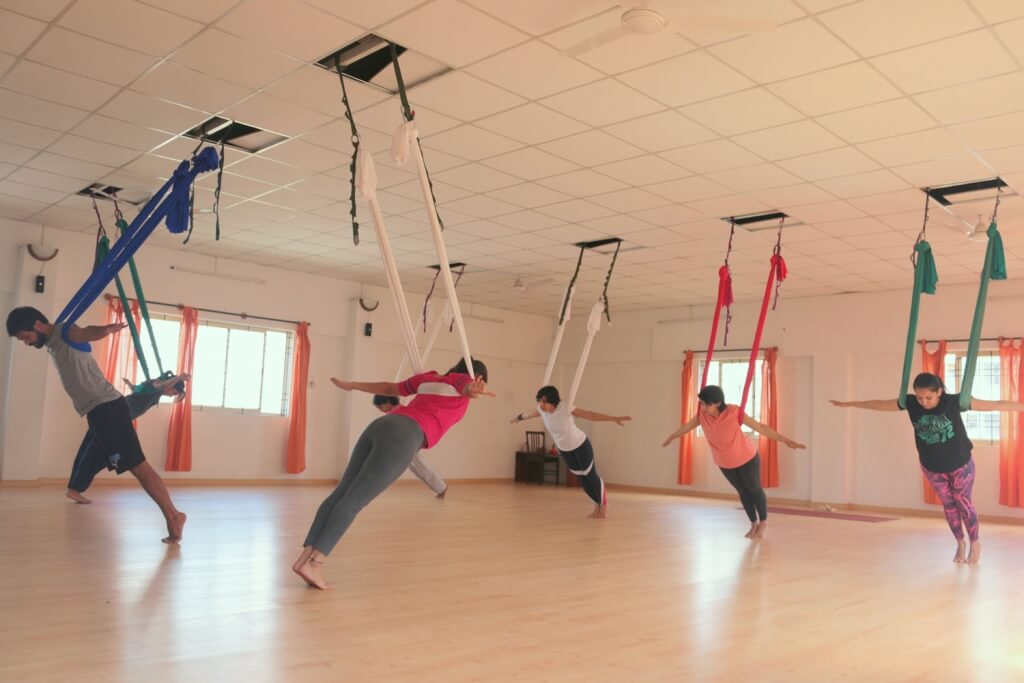
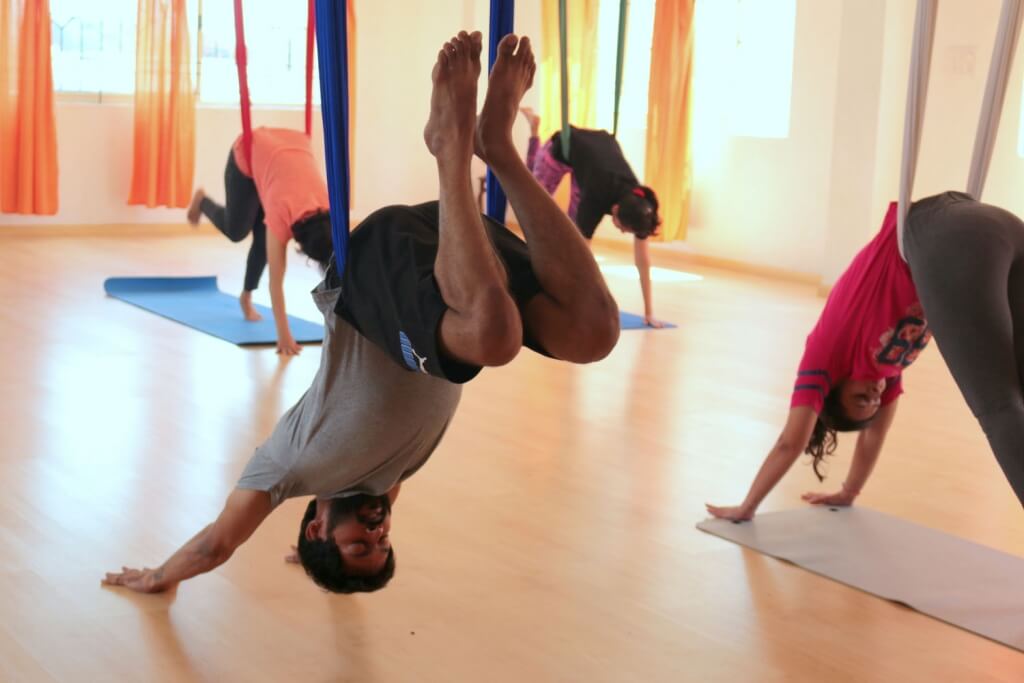
[Left: aerial plank; Right: downward dog variation]
Very soon, we’re attempting a downward dog variation – a struggle, as I’m about to discover. He is now expecting us to flop over the hammock, walk our palms forward on the mat below AND lift our heels up, close to our buttocks. It’s scary to try and hold your feet up in the air, connect with your breath, find balance and stabilise a swaying hammock all at once. My mind refuses to oblige, almost certain I’ll fall over.
Yuva comes around and assists everyone. He gently lifts my right foot off the floor and holds on while I lift the other. And just like that, my legs are airborne.
“Now into an aerial vrikshasana (tree pose)”, he proceeds. We’ll need to climb onto the closely gathered sling, stand on one foot and with the other foot pressed on the thigh of the first, join our palms together.
“I think I’ll skip,” I say aloud.
“Give it a try,” he encourages.
The learning curve is steep, but after a few failed attempts and a renewed focus, I’m posing like an aerial acrobat. Well, almost.
Next is a flying salabhasana (locust pose): with body parallel to the floor, the hammock supporting my hips, and arms stretched farther back gripping the insides of the harness, I fly back and forth. I feel it in my torso, arms and legs, but more importantly, I feel empowered and liberated. Whoa! Like a bird, like a plane…. like Superman!
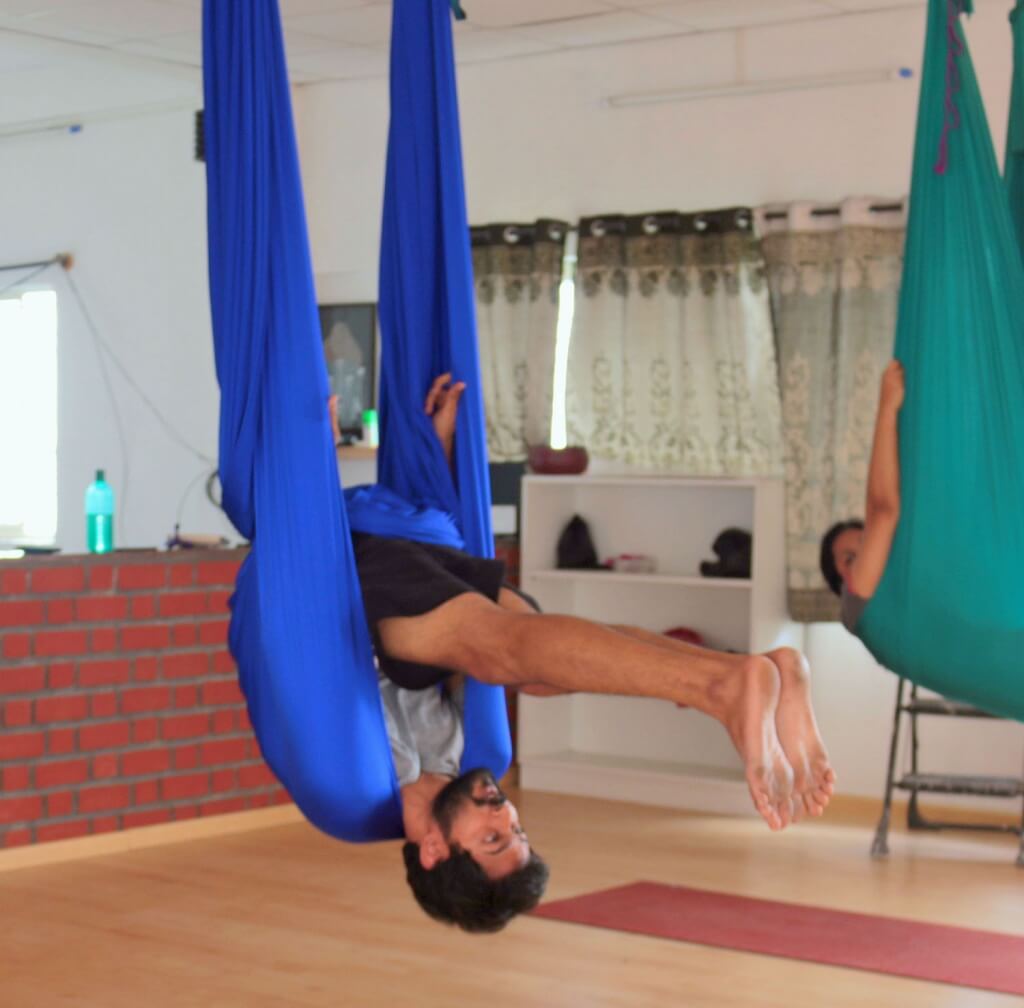
[Halasana (plow pose)]
Before I can bask in the glory of my accomplishments, along comes a halasana (plow pose) and the dreaded reverse flip. With the hammock cradling his body from the shoulders to the back of his thighs, Yuva demonstrates, bringing his feet together over his head and then onto the floor with fluidity and control.
My heart is now racing. He walks over, calmly and gently directs my movements, breaking them down into easy steps. And before I know it, I have touched down and also flipped away my fears. When I try it again on my own, though, I land short with a wobble and a stumble. An aerial bridge and mermaid pose (both backbends) follow, but I cruise ahead in full control.
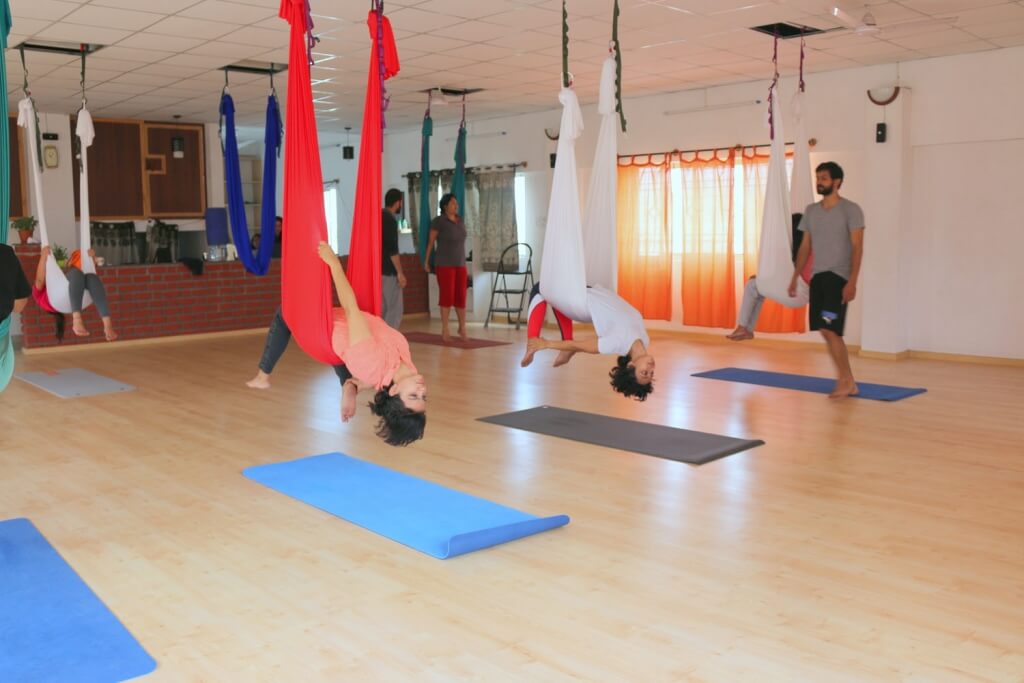
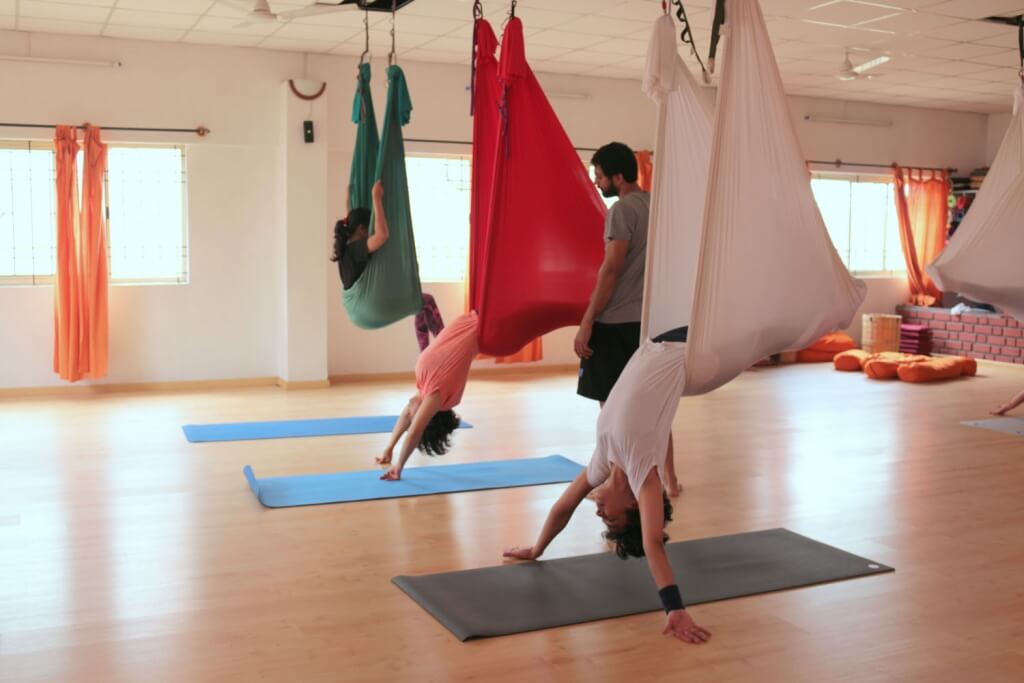
[Left: aerial bridge; Right: aerial mermaid]
Last up is the king of poses: sirsasana (headstand). In the aerial inversion, you’re upside down with your head several inches above the floor, supported only by the hammock wrapped around your hips and legs. I pause, waiting to see who among my classmates will be brave enough to hang like a bat first. One of them reports dizziness. Another lets out a brief stifled scream before struggling into the pose. I try hard not to allow their reactions feed my insecurities.
Some deep breaths and few alignment corrections later, I’m fully inverted. My feet are joined together, palms facing the ceiling, my head and hips heavy, and as I let go and let the hammock take control, I feel my spine lengthen and my worries melt away. I feel as though I could hang like this forever.
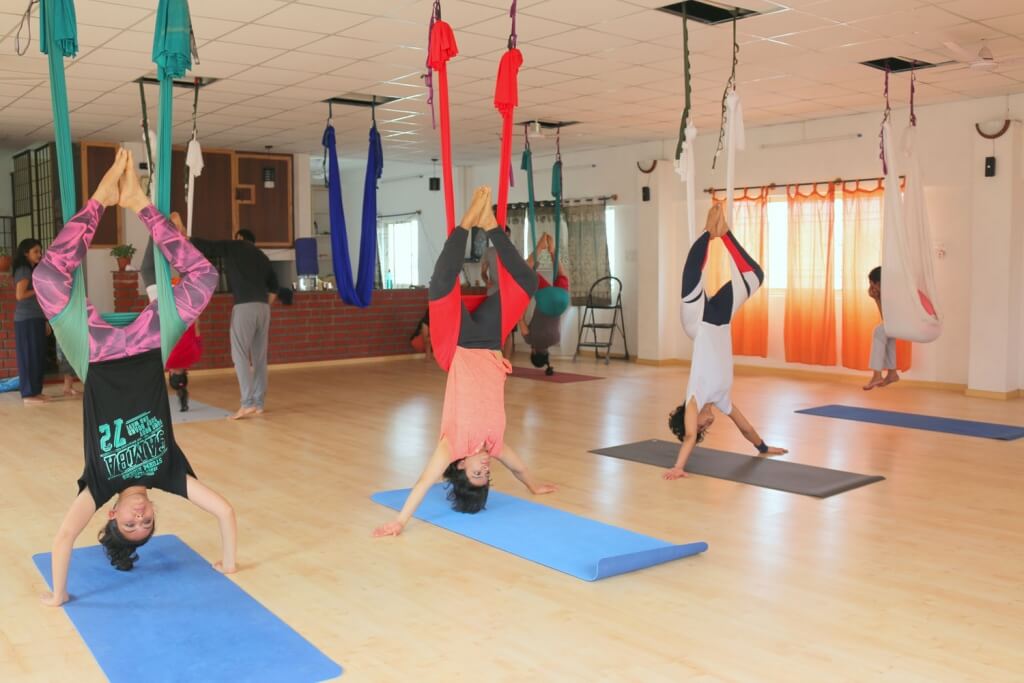
[Sirsasana (headstand)]
“Everything alright?” my teacher enquires.
“Couldn’t ask for better,” I reply. He begins to spin me around 360o. “Slow down,” I plead, feeling a bit woozy.
As we wrap up, lying cocooned in our hammocks, settling into shavasana (corpse pose), I’m filled with an extraordinary sense of relief mixed with satisfaction and pride.
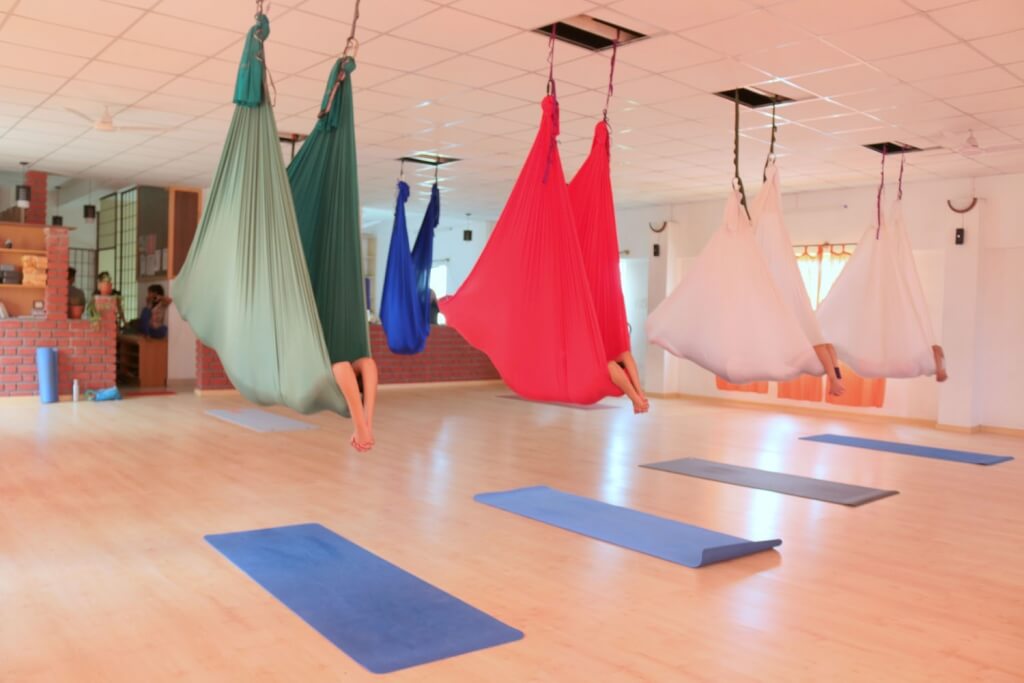
[Shavasana (corpse pose)]
“What made those intimidating 75 minutes a success and less of a struggle?” I wonder. Then it occurs to me: while it was certainly beneficial to have an ongoing vinyasa and hatha yoga practice, success primarily came from being mindfully focused on the task at hand, following the teacher’s instructions closely and trusting the hammock fully. By pushing myself a little bit at a time, I was able to gradually build the skills and confidence to perform the impossible, and also break those horrifying reels in my head.
When you hit that sweet spot, where fear gives way to confidence, that’s when you truly witness the exhilaration of floating freely – and mind you, it doesn’t come from simply being suspended in a hammock.
[Photos: Prahlad Shrinivas]



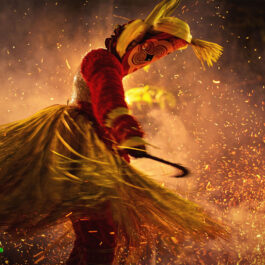




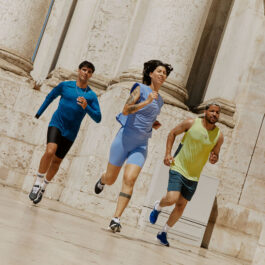
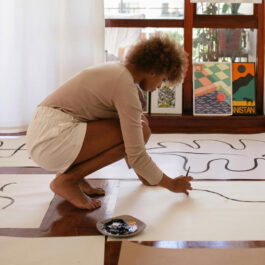




Sorry, the comment form is closed at this time.